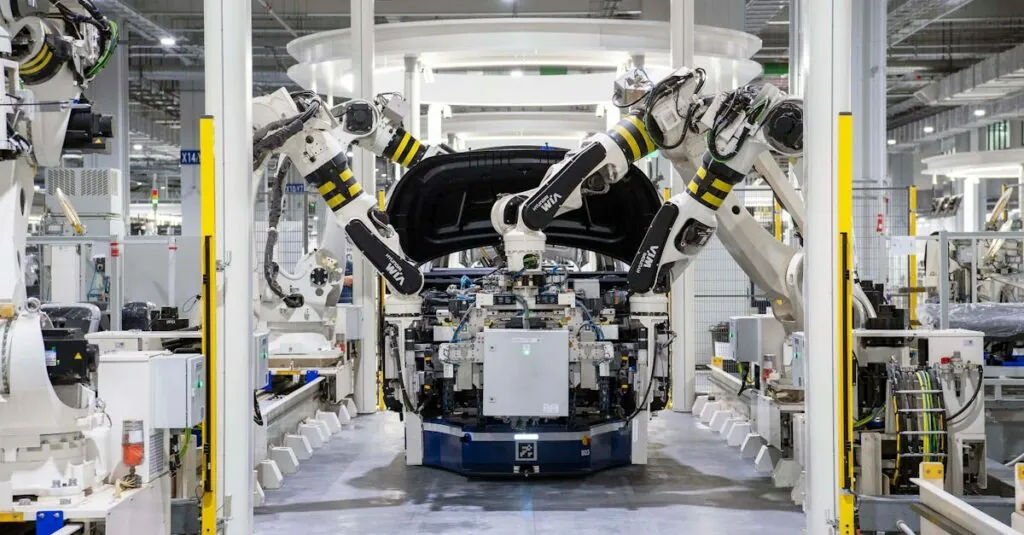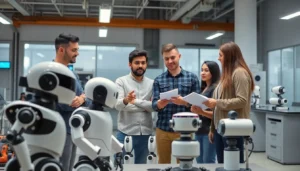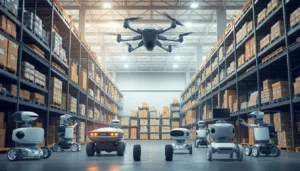In a world where robots are no longer just the stuff of sci-fi movies, the robotics and automation industry is booming like never before. Picture this: machines that can assemble cars, deliver packages, and even serve your coffee—all while you kick back and binge-watch your favorite show. It’s not just a dream; it’s happening right now, and it’s changing the way businesses operate.
Table of Contents
ToggleOverview of Robotics and Automation Industry
The robotics and automation industry experiences significant expansion, adapting to various sectors. Robots and automated systems play crucial roles across diverse applications, enhancing efficiency and productivity.
Definition of Robotics and Automation
Robotics entails designing and constructing robots to perform tasks autonomously or semi-autonomously. Automation incorporates technology to execute processes without human intervention, often utilizing robotics to streamline operations. Both fields encompass hardware and software, enabling machines to perform intricate tasks ranging from assembly line work to surgical procedures effectively.
Importance in Modern Economy
The modern economy significantly benefits from robotics and automation. Productivity enhances as firms adopt these technologies, reducing labor costs and minimizing errors. According to the International Federation of Robotics, the global stock of operational industrial robots reached 3 million units in 2020. This adoption leads to improved efficiency in industries like manufacturing, logistics, and healthcare. Furthermore, robotics and automation drive innovation, creating new job opportunities in advanced tech sectors, thus reshaping the workforce landscape.
Key Technologies in Robotics and Automation
Robotics and automation leverage various key technologies to enhance their capabilities. These technologies drive efficiency, improve precision, and enable advanced functionalities across multiple applications.
Artificial Intelligence
Artificial intelligence (AI) equips robots with the ability to perform tasks that require decision-making and adaptation. AI systems analyze data from sensors to optimize operations, making robots capable of learning from their environments. For instance, robots in manufacturing use AI for quality control, identifying defects in real time. AI-powered chatbots also enhance customer service by delivering personalized responses quickly. The integration of AI into robotics significantly elevates performance and enables tasks that were once considered complex.
Machine Learning
Machine learning (ML), a subset of AI, empowers robots to improve their performance through experience. By analyzing large datasets, these systems identify patterns and make predictions. For example, warehouse robots use ML algorithms to optimize inventory management, making real-time adjustments based on demand fluctuations. In healthcare, ML supports robotic surgical systems, enhancing precision during procedures. The continuous advancement in machine learning contributes to developing smarter robots that adapt to new tasks efficiently.
Internet of Things (IoT)
The Internet of Things (IoT) facilitates connectivity between robots and other devices, creating a smart ecosystem. IoT enables seamless data exchange, allowing robots to communicate with sensors and networks. For instance, delivery drones equipped with IoT can reroute themselves in response to real-time traffic data. In manufacturing, connected machines improve predictive maintenance, reducing downtime and operational costs. The rise of IoT in robotics transforms industries by enabling real-time monitoring and control of automated systems.
Applications of Robotics and Automation
Robotics and automation play crucial roles across various industries, enhancing efficiency and effectiveness in operations.
Manufacturing Sector
Robots actively perform assembly tasks, welding, and painting in manufacturing settings. Their precision improves product quality while decreasing waste. In 2020, the global stock of operational industrial robots reached 3 million units, underlining their importance. Collaborative robots, or cobots, work alongside human operators, increasing safety and productivity. Automation also aids in quality control, ensuring products meet strict specifications without human error. This integration speeds up production lines and boosts overall efficiency.
Healthcare Industry
Automation transforms the healthcare industry through robotic surgical systems and patient care assistants. Surgical robots assist in minimally invasive procedures, enhancing precision and recovery times. Additionally, robotic devices handle medication dispensing and patient monitoring, allowing healthcare professionals to focus on critical tasks. Telepresence robots enable remote consultations, improving access to specialists. Automation in healthcare leads to better patient outcomes and more efficient hospital operations, demonstrating its vital contribution to modern medicine.
Transportation and Logistics
Drones and automated vehicles revolutionize transportation and logistics. Delivery drones streamline package distribution, reaching remote areas quickly. Automated guided vehicles (AGVs) transport goods within warehouses efficiently, reducing human labor costs. Inventory management improves with robotics, as automated systems track stock levels and predict demands. Advanced technologies, such as AI and IoT, enhance route optimization and fleet management. Transportation and logistics increasingly rely on these innovations to meet growing consumer demands and improve service efficiency.
Challenges in the Robotics and Automation Industry
The robotics and automation industry faces several significant challenges affecting its growth and implementation.
Workforce Impact
Job displacement remains a pressing concern as automation replaces roles traditionally held by human workers. Many low-skill positions are at higher risk, triggering economic shifts in affected sectors. Upskilling programs become essential, enabling workers to transition into new roles that require more advanced skills. Many companies invest in training initiatives to mitigate the impact on their workforce. As a result, collaboration between government, industry, and educational institutions is critical in fostering a workforce prepared for the future.
Ethical Considerations
Ethical implications arise from the increasing reliance on robotics in daily life. Privacy issues gain attention, especially with robots collecting vast amounts of data. Accountability challenges emerge when automated systems make decisions that impact safety or jobs. Bias in AI algorithms raises concerns about fairness and equality in automation practices. Stakeholders must address these issues to promote ethical standards, ensuring technology benefits society while minimizing negative repercussions.
Technological Limitations
Technological constraints hinder the full potential of the robotics and automation industry. Many existing systems struggle with complex tasks requiring human-like judgment and adaptability. Limitations in battery life restrict the operational capabilities of mobile robots. Additionally, integration challenges occur when connecting disparate systems within an organization. Progress continues, but overcoming these technological hurdles is crucial to enhancing functionality and efficiency in robotic applications.
Future Trends in Robotics and Automation
Robotics and automation are on the verge of significant advancements influenced by ongoing technological innovations and industry demands.
Emerging Technologies
Artificial intelligence continues to enhance robotic capabilities. AI allows robots to learn from their experiences, improving their efficiency in tasks like quality control and customer service. Machine learning further refines their abilities, enabling smarter decision-making through data analysis. The integration of the Internet of Things connects robots with other devices, fostering real-time interactions and streamlining operations. Innovations in sensors and computer vision also contribute to the precision and adaptability of robots, essential in dynamic environments such as warehouses and healthcare facilities. These emerging technologies not only boost performance but also expand the potential applications of robotics across diverse sectors.
Market Growth Projections
The robotics and automation market is poised for exponential growth in the coming years. Market research predicts a compound annual growth rate of 26.9% from 2021 to 2028. This surge correlates directly with increased adoption across manufacturing, logistics, and healthcare sectors. By 2026, the global industrial robotics market alone is expected to exceed $60 billion. Increased investment in automation technologies aims to enhance productivity and address labor shortages. As companies prioritize efficiency and innovation, the demand for robotics solutions will continue to rise, shaping the future landscape of various industries.
The robotics and automation industry stands at the forefront of technological advancement. Its integration into various sectors not only enhances efficiency but also drives innovation and economic growth. As companies adapt to these changes the demand for skilled workers will rise, emphasizing the importance of upskilling and education.
While challenges such as job displacement and ethical considerations persist the potential for robotics to reshape industries is undeniable. With continued advancements in AI and machine learning the future looks promising. The industry’s trajectory suggests a transformative impact on how businesses operate and interact with consumers. Embracing these technologies will be crucial for organizations aiming to thrive in an increasingly automated world.










